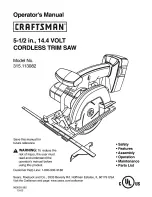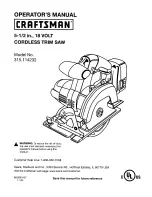
6
- If the blade becomes twisted or misaligned in the cut,
the teeth at the back edge of the blade can dig into the
top surface of the wood causing the blade to climb
out of the kerf and jump back toward the operator.
Kickback is the result of saw misuse and/or incor
-
rect operating procedures or conditions and can be
avoided by taking proper precautions as given below:
• Maint
ain a firm grip with both hands on the saw and
position your arms to resist kickback forces. Posi
-
tion your body to either side of the blade, but not
in line with the blade.
Kickback could cause the saw
to jump backwards, but kickback forces can be con
-
trolled by the operator, if proper precautions are taken.
• When blade is binding, or when interrupting a
cut for any reason, release the trigger and hold
the saw motionless in the material until the
blade comes to a complete stop. Never attempt
to remove the saw from the work or pull the saw
backward while the blade is in motion or kick
-
back may occur.
Investigate and take corrective
actions to eliminate the cause of blade binding.
• When restarting a saw in the workpiece, centre
the saw blade in the kerf and check that saw
teeth are not engaged into the material.
If saw
blade is binding, it may walk up or kickback from the
workpiece as the saw is restarted.
• Support large panels to minimise the risk of
blade pinching and kickback.
Large panels tend
to sag under their own weight. Supports must be
placed under the panel on both sides, near the line
of cut and near the edge of the panel.
• Do not use dull or damaged blades.
Unsharpened
or improperly set blades produce narrow kerf caus-
ing excessive friction, blade binding and kickback.
• Blade depth and bevel adjusting locking levers
must be tight and secure before making cut.
If
blade adjustment shifts while cutting, it may cause
binding and kickback.
• Use extra caution when sawing into existing
walls or other blind areas.
The protruding blade
may cut objects that can cause kickback.
General Operation
Always clamp the workpiece securely on a saw horse
or bench. See “APPLICATIONS” for the correct way
to support your work in different situations.
1. Draw a cutting line. Place the front of the shoe on
the edge of the workpiece without making blade
contact. Hold the handle with one hand and the
front handle with the other.
2. Line up the sight line with your cutting line. Position
your arms and body to resist KICKBACK.
3. To start the saw, push the lock-off button down
while pulling the trigger. Allow the motor to reach
full speed before beginning cut.
4. While cutting, keep the shoe flat against the
workpiece and maintain a firm grip. Do not force
the saw through the workpiece. Forcing a saw can
cause KICKBACK.
5. If making a partial cut, restarting in mid-cut or
correcting direction, allow the blade to come to a
complete stop. To resume cutting, center the blade
in the kerf, back the saw away from cutting edge
a few inches, push the lock-off button down while
pulling the trigger and re-enter the cut slowly.
6. If the saw binds and stalls, maintain a firm grip
and release the trigger immediately. Hold the saw
motionless in the workpiece until the blade comes
to a complete stop.
7. After finishing a cut, be sure the lower guard closes
and the blade comes to a complete stop before
setting the saw down.
Electric Brake
The electric brake engages when the trigger is re-
leased, causing the blade to stop and allowing you
to proceed with your work. Generally, the saw blade
stops within two seconds. However, there may be a de
-
lay between the time you release the trigger and when
the brake engages. Occasionally the brake may miss
completely. If the brake misses frequently, the saw
needs servicing by an authorized MILWAUKEE ser-
vice facility. The brake is not a substitute for the guard,
and you must always wait for the blade to stop com-
pletely before removing the saw from the workpiece.
Troubleshooting
If the blade does not follow a straight line:
• Teeth are dull. This is caused by hitting a hard object
such as a nail or stone, dulling teeth on one side. The
blade tends to cut to the side with the sharpest teeth.
• Shoe is out of line or bent
• Blade is bent
• Rip fence or guide is not being used
If the blade binds, smokes or turns blue from friction:
• Blade is dull
• Blade is on backwards
• Blade is bent
• Blade is dirty
• Workpiece is not properly supported
• Incorrect blade is being used
• Battery charge is low
APPLICATIONS
Cutting Large Panels
Large panels and long boards sag or bend if they are
not correctly supported. If you attempt to cut without
leveling and properly supporting the workpiece, the
blade will tend to bind, causing KICKBACK
.
Support large panels. Be sure to set the depth of the
cut so that you only cut through the workpiece, not
through the supports.

























